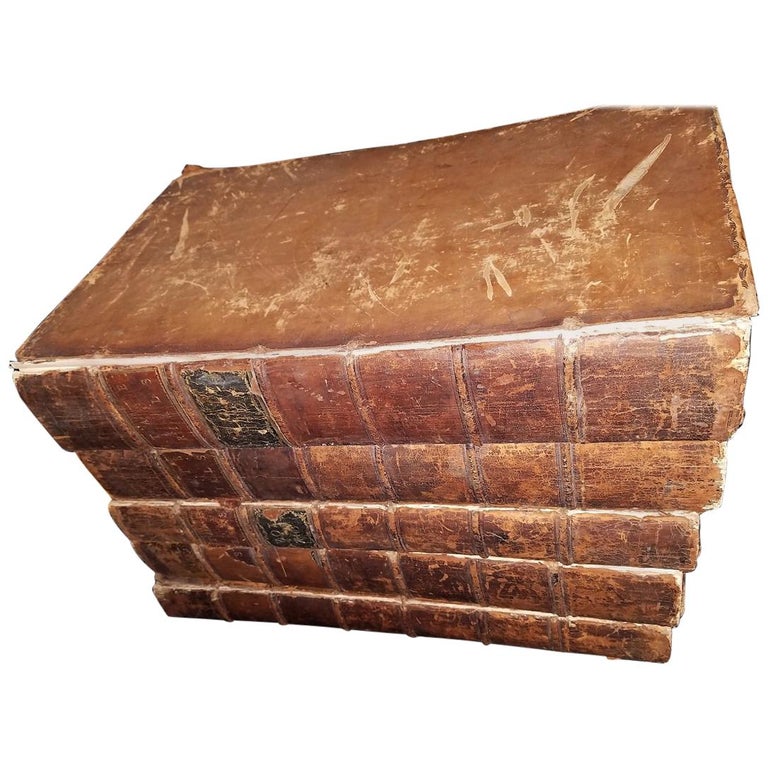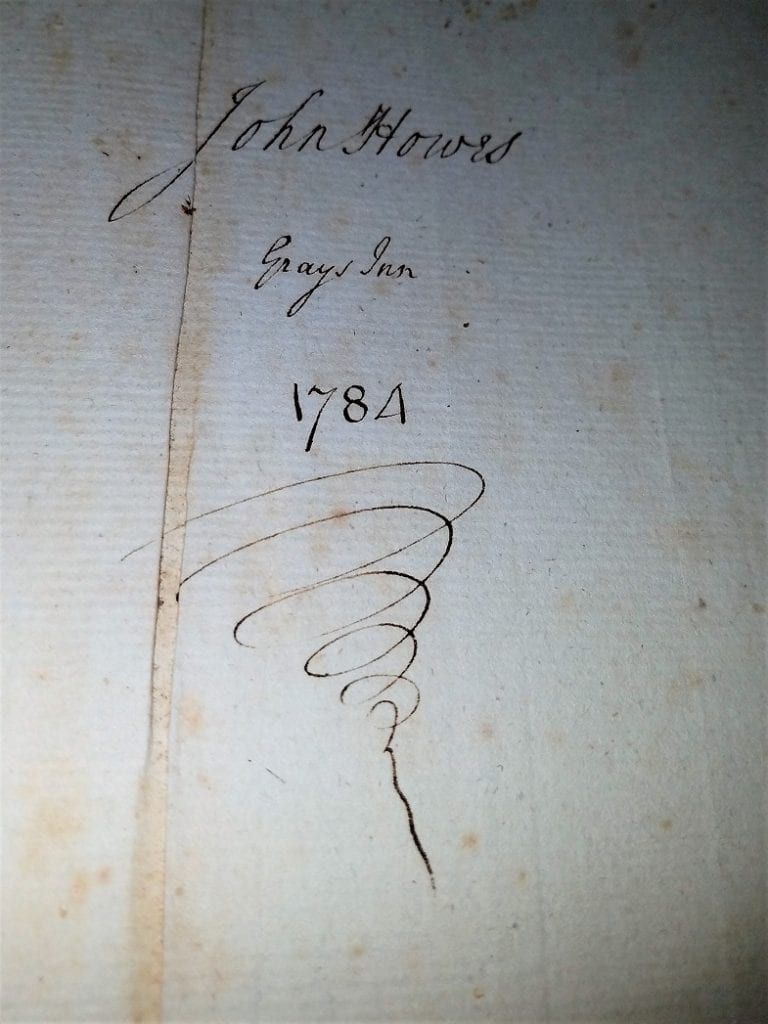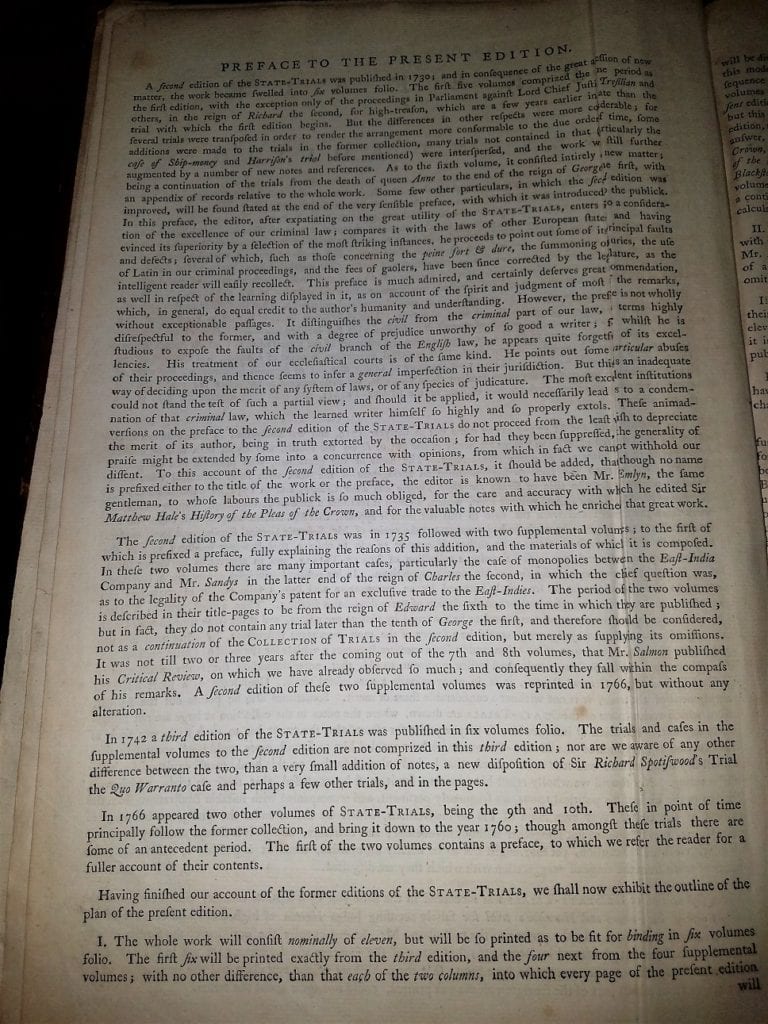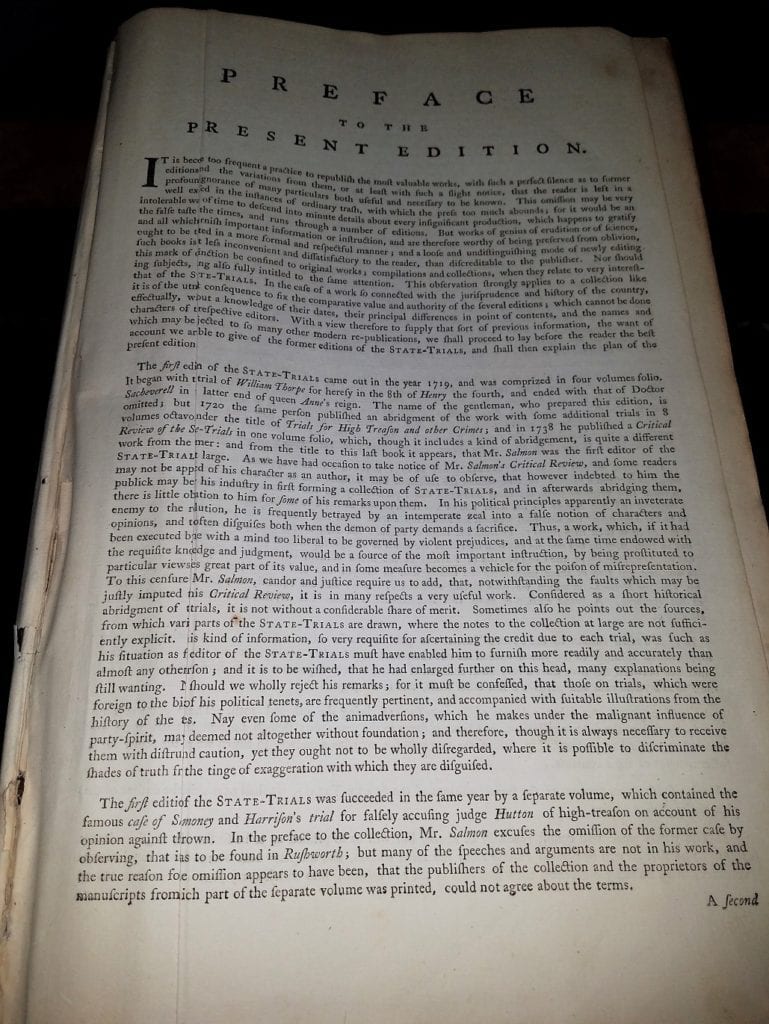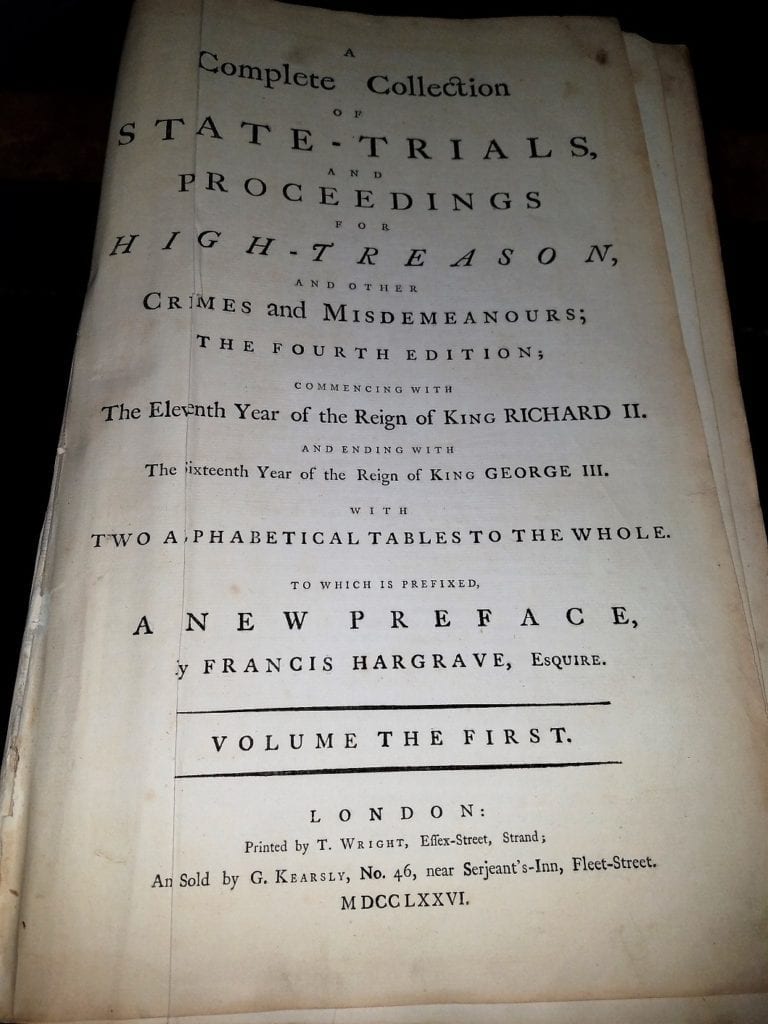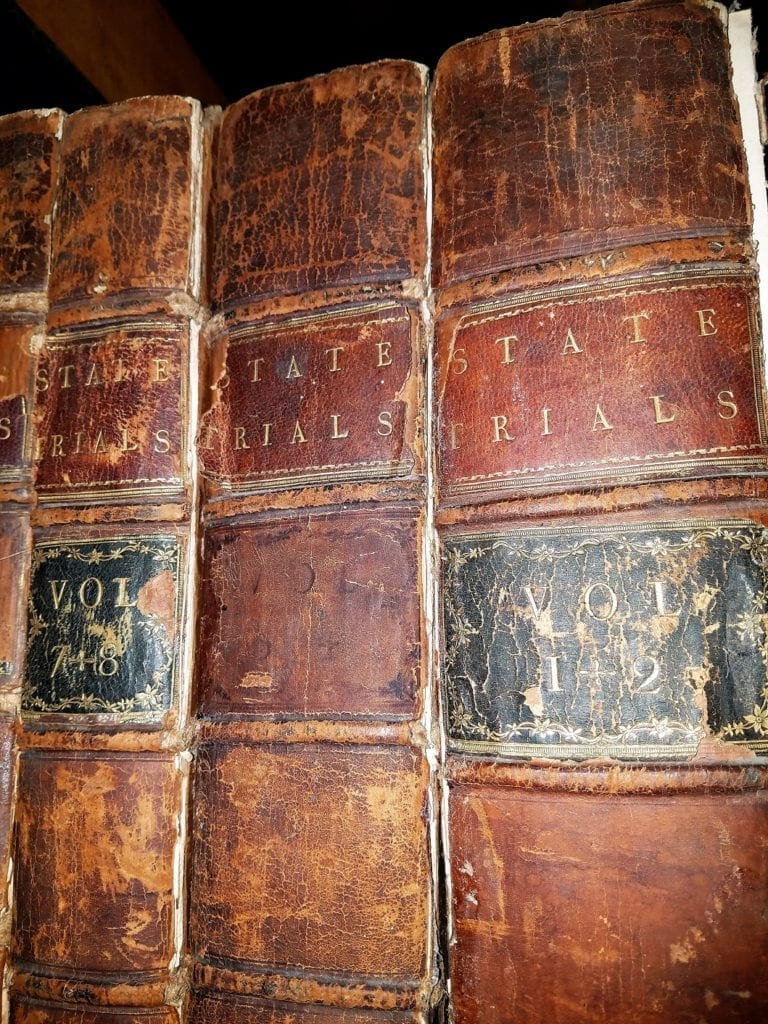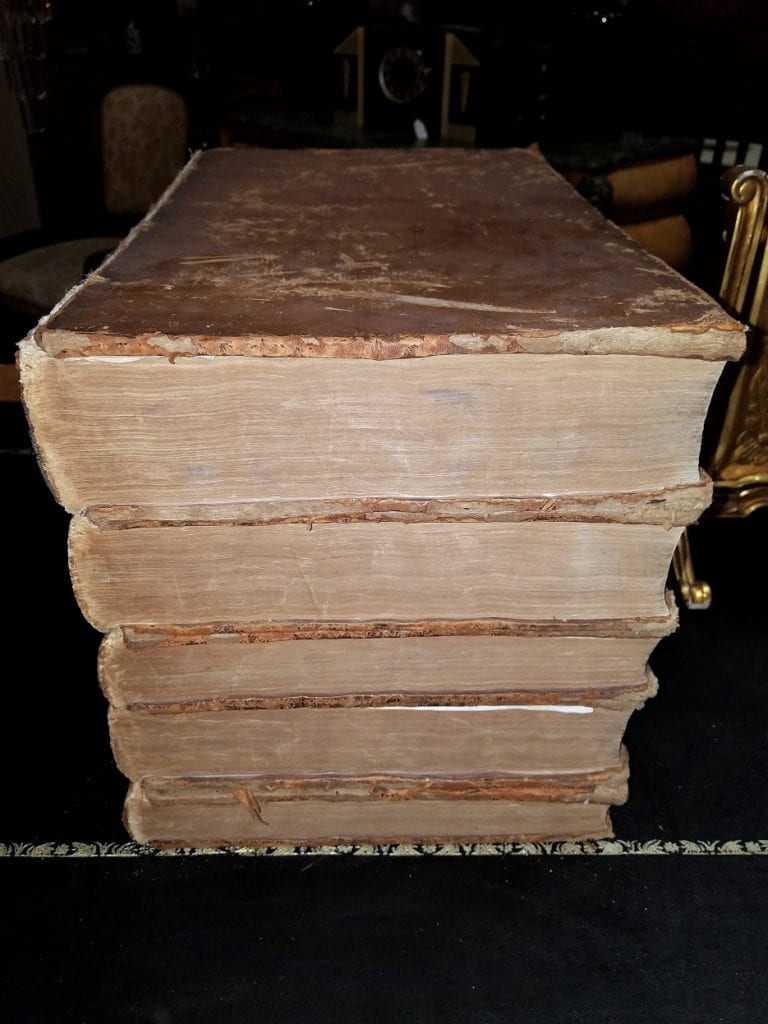1781 State Trials for High Treason – IMPORTANT
PRESENTING an EXTREMELY RARE, TRULY HISTORIC, IMPORTANT and HIGHLY DESIRABLE set of 5 leather bound Volumes of the Fourth Edition 1781 State Trials for High Treason, and other Crimes and Misdemeanors, editorialized by Francis Hargrave Esq. and 2 of which are signed by their owner, John Howes of Grays Inns, The Old Bailey, London in 1784.
These Volumes were published in 1781 and deal with the various famous State Trials and Proceedings for High Treason, Commencing from the 11th Year of the Reign of King Richard II to the 16th Year of the Reign of King George III.
Included in the recorded Trials, are such notable Trials as:
King Charles I
Sir Walter Raleigh
Anna Boleyn (Henry VIII)
Sir Thomas Moore (Henry VIII)
Edward Duke of Buckingham (Henry VIII)
John Dudley (Queen Mary)
Philip Howard (Elizabeth I)
Mary Queen of Scots (Elizabeth I)
Guy Fawkes & The Gunpowder Plotters (Elizabeth I)
Oliver St John (James I)
John Wilkes
James Sommerset (ending slavery in the UK)
Oliver Plunket
AND MANY MORE!
What makes these Volumes of EVEN MORE INTEREST is that they were owned by a ‘JOHN HOWES’ in 1784, who gives his address as GRAY’S INNS.
Mr. Howes was obviously a Barrister attached to the famous Law Chambers of Gray’s Inns in the Old Bailey in 1784.
The Honourable Society of Gray’s Inn, commonly known as Gray’s Inn, is one of the four Inns of Court (professional associations for barristers and judges) in London. To be Called to the Bar and practise as a barrister in England and Wales, an individual must belong to one of these Inns. Located at the intersection of High Holborn and Gray’s Inn Road in Central London, the Inn is both a professional body and a provider of office accommodation (chambers) for many barristers. It is ruled by a governing council called “Pension”, made up of the Masters of the Bench (or “Benchers“), and led by the Treasurer, who is elected to serve a one-year term. The Inn is known for its gardens, or Walks, which have existed since at least 1597.
Gray’s Inn does not claim a specific foundation date; there is a tradition that none of the Inns of Court claims to be any older than the others. Law clerks and their apprentices have been established on the present site since at least 1370, with records dating from 1381. During the 15th and 16th centuries, the Inn grew steadily with great prestige, reaching its pinnacle during the reign of Elizabeth I. The Inn was home to many important barristers and politicians, most notably Francis Bacon, and counted Elizabeth herself as a patron. Thanks to the efforts of prominent members such as William Cecil and Gilbert Gerard, Gray’s Inn became the largest of the four by number, with over 200 barristers recorded as members. During this period, the Inn became noted for the masques and revels that it threw, and William Shakespeare is believed to have first performed the Comedy of Errors play there.
The Inn continued to prosper during the reign of James I (1603–1625) and the beginning of that of Charles I, when over 100 students per year were recorded as joining. The outbreak of the First English Civil War in 1642 during the reign of Charles I disrupted the systems of legal education and governance at the Inns of Court, shutting down all calls to the Bar and new admissions, and Gray’s Inn never fully recovered. Fortunes continued to decline after the English Restoration, which saw the end of the traditional method of legal education. Although now more prosperous, Gray’s Inn is today the smallest of the Inns of Court.
Gray’s Inn and the other three Inns of Court remain the only bodies legally allowed to call a barrister to the Bar, allowing him or her to practise in England and Wales. Although the Inn was previously a disciplinary and teaching body, these functions are now shared between the four Inns, with the Bar Standards Board (a division of the General Council of the Bar) acting as a disciplinary body and the Inns of Court and Bar Educational Trust providing education. The Inn remains a collegiate self-governing, unincorporated association of its members, providing within its precincts library, dining, residential and office accommodation (chambers), along with a chapel. Members of the Bar from other Inns may use these facilities to some extent.
The fortunes of Gray’s Inn continued to decline after the English Restoration, and by 1719 only 22 students were joining the Inn a year. This fall in numbers was partly because the landed gentry were no longer sending sons who had no intention of becoming barristers to study at the Inn. In 1615, 13 students joined the Inn for every student called to the Bar, but by 1713 the ratio had become 2.3 new members to every 1 call.
Over a 50-year period, the Civil War and high taxation under William III economically crippled many members of the gentry, meaning that they could not afford to allow their sons to study at the Inns. David Lemmings considers it to have been more serious than that, for two reasons; firstly, Inner Temple and Middle Temple had actually shown an increase in membership following the Restoration, and secondly because Gray’s Inn had previously had far more “common” members than the other Inns. The decrease in the number of gentry at the Inn could therefore not completely explain the large drop in members.
Gray’s Inn was the venue for an early first-class cricket match on Thursday, 2 July 1730 between London and Kent. Kent won the game by an unknown margin. The original source reports “a cricket-match between the Kentish men and the Londoners for £50, and won by the former”, giving the precise location as “a field near the lower end of Gray’s Inn Lane, London“.
In 1733 the requirements for a call to the Bar were significantly revised in a joint meeting between the Benchers of Inner Temple and Gray’s Inn, revisions accepted by Lincoln’s Inn and Middle Temple, although they were not represented. It is not recorded what these changes were, but after a further discussion in 1762 the Inns adopted a rule that any student with a Master of Arts or Bachelor of Laws degree from the universities of Oxford or Cambridge could be called to the Bar after three years as a student, and any other student could be called after five years. An attempt was made to increase the quality of legal education at Gray’s Inn; in 1753 a barrister, Danby Pickering, was employed to lecture there, although this agreement ended in 1761 when he was called to the Bar.
The 18th century was not a particularly prosperous time for the Inn or its members, and few notable barristers were members during this period. Some noted members include Sir Thomas Clarke, the Master of the Rolls, Sir James Eyre, Chief Justice of the Common Pleas and Samuel Romilly, a noted law reformer. In 1780 the Inn was involved in the case of R v the Benchers of Gray’s Inn, a test of the role of the Inns of Court as the sole authority to call students to the Bar. The case was brought to the Court of King’s Bench by William Hart, a student at the Inn, who asked the court (under Lord Mansfield) to order the Inn to call him to the Bar. Mansfield ruled that the Inns of Court were indeed the only organisations able to call students to the Bar, and refused to order the Inns to call Hart.
During the 19th century, the Inns began to stagnate; little had been changed since the 17th century in terms of legal education or practice, except that students were no longer bound to take the Anglican sacrament before their call to the Bar. In 1852 the Council of Legal Education was established by the Inns, and in 1872 a formal examination for the call to the Bar was introduced. Gray’s Inn itself suffered more than most; as in the 18th century, the fortunes of its members declined, and many barristers who had been called to the Bar at the Inn transferred to others.
Gray’s Inn was the smallest of the Inns during the early 20th century, and was noted for its connection to the Northern Circuit. During the Second World War, the Inn was badly damaged during the Blitz in 1941, with the Hall, the Chapel, the Library and many other buildings hit and almost destroyed. The rebuilding of much of the Inn took until 1960 by the architect Sir Edward Maufe. In 2008 Gray’s Inn became the first Inn to appoint “fellows”—elected businesspeople, legal academics and others—with the intent of giving them a wider perspective and education than the other Inns would offer.
The Library of Gray’s Inn has existed since at least 1555, when the first mention of it was made in the will of Robert Chaloner, who left some money to buy law books for the Library. The Library was neither a big collection nor a dedicated one; in 1568 it was being housed in a single room in the chambers of Nicholas Bacon, a room that was also used for mooting and to store the deed chest. The collection grew larger over the years as individual Benchers such as Sir John Finch and Sir John Bankes left books or money to buy books in their wills, and the first Librarian was appointed in 1646 after members of the Inn had been found stealing books.
In 1669 books were bought by the Inn as an organisation for the first time, and a proper catalogue was drawn up to prevent theft. In 1684 a fire that broke out in Coney Court, where the Library was situated, and destroyed much of the collection. While some books were saved, most of the records prior to 1684 were lost. A “handsome room” was then built to house the Library.
The Library became more important during the 18th century; prior to that it had been a small, little-used collection of books. In 1725 it was proposed by the Pension that “a publick Library be sett up and kept open for ye use of ye society”, and that more books be purchased. The first order of new books was on 27 June 1729 and consisted of “a collection of Lord Bacon‘s works”. In 1750 the Under-Steward of the Inn made a new catalogue of the books, and in 1789 the Library was moved to a new room between the Hall and the Chapel. In 1840 another two rooms were erected in which to store books, and in 1883 a new Library was constructed with space to store approximately 11,000 books. This was rapidly found to be inadequate, and in 1929 a new Library, known as the Holker Library after the benefactor, Sir John Holker, was opened. The library, although impressive looking, was not particularly useful; Francis Cowper wrote that:
Though impressive to look at, the new building was something less than a success as a library. The air of spaciousness was produced at the expense of shelf room, and though in the octagon [at the north end] the decorative effect of row upon row of books soaring upwards towards the cornice was considerable, the loftiest were totally inaccessible save to those who could scale the longest and dizziest ladders. Further, the appointments were of such surpassing mag-nificence that no ink-pots were allowed in the room for fear of accidents.[110]
The building did not last very long—damage to the Inn during the Blitz completely destroyed the Library and a large part of its collection, although the rare manuscripts, which had been moved elsewhere, survived. After the destruction of much of the Inn’s collection, George VI donated replacements for many lost texts. A prefabricated building in the Walks was used to hold the surviving books while a new Library was constructed, and the new building (designed by Sir Edward Maufe) was opened in 1958. It is similar in size to the old Holker Library, but is more workmanlike and designed to allow for easy access to the books.
Link: https://en.wikipedia.org/wiki/Gray%27s_Inn
YOU WILL NOT FIND ANOTHER SET LIKE THIS ANYWHERE.
THE LIBRARY AT GRAY’S INNS POSSIBLY HAS A SET LIKE THIS … BUT PROBABLY NOT SIGNED BY A FORMER MEMBER OF THE SOCIETY OF THE PERIOD!
1781 State Trials for High Treason signed by John Howes Grays Inns 1784.
Provenance: Bought from an English Private Collector in 1995.
Condition: Some damage and losses to the leather bindings. Some covers are loose and separated. Some foxing and discoloration and some creasing to some of the pages. But in remarkably good condition considering their age. Would greatly benefit from professional re-binding.
Dimensions: 11 inches wide, 17.2 inches long and 12 inches deep (set of 5)
